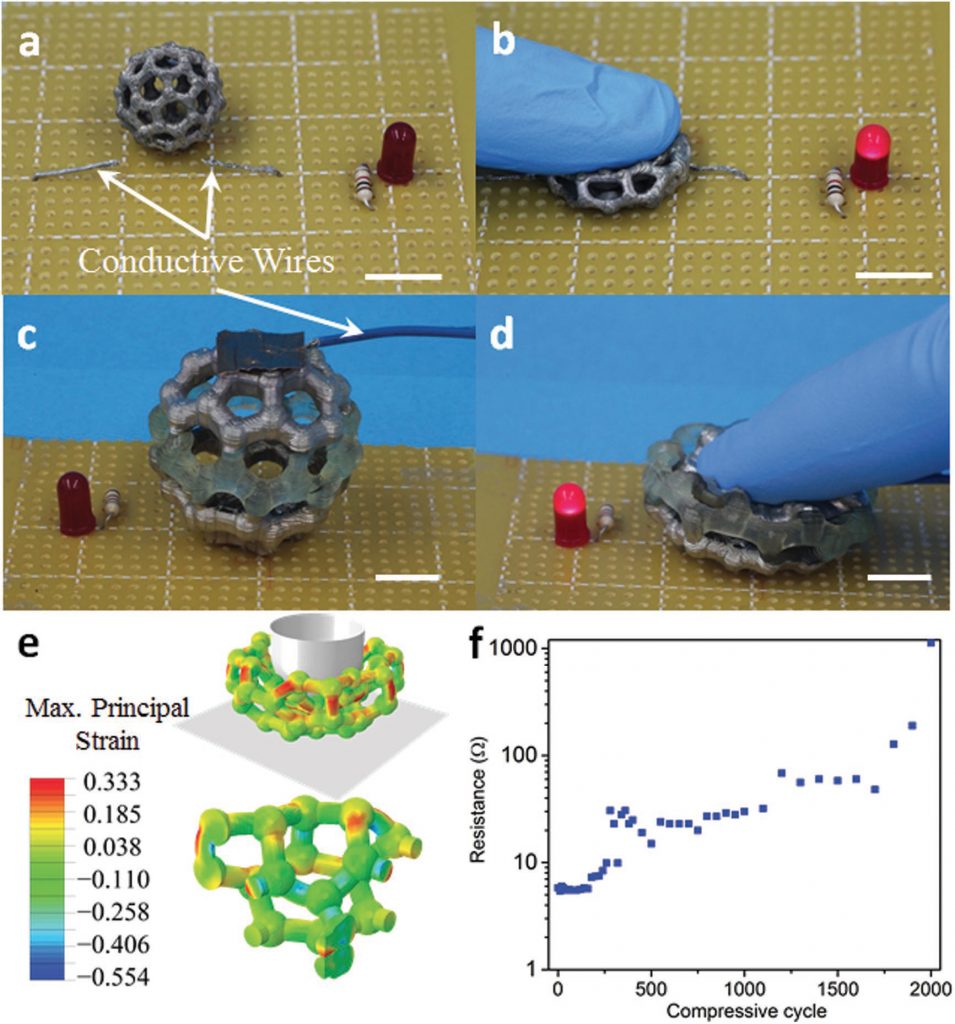Published in the journal of Advanced Materials on 7 February 2017, researchers from Singapore and Israel demonstrate a range of stretchy materials suitable for vat polymerisation 3D printing.
Such materials are usually created through combination of 3D printing and traditional methods. 3D printing without traditional input allows much more design freedom to the finished objects. Complex geometries can be created that allow objects mechanical strength and flexibility, i.e. they can squash into small places, and transform into new shapes.
Applying the concept to flexible electronics, the team also create a flexible switch that conducts electricity, demonstrating the materials’ potential use in the field of flexible electronics as in Nano Dimension’s 3D printed PCBs, or flexible LED screen research.
Method of production
The stretchable and UV curable (SUV) elastomers are created by mixing Allnex EBECRYL resin strains 8413 (AUD) and 113 (EAA). This compound resin is then 3D printed using a Pico Plus39 LED DLP 3D printer from the Australia based company Asiga. To retain elasticity, the resin bath is modified to keep a consistent temperature of 70 degrees Celsius.

Though DLP is the primary method explored in the study, the authors also stipulate that the technique is transferable to other modes of vat polymerisation such as SLA and CDLP.
As proof of concept, several different flexible structures are explored in the study, including a soft actuator, responsible for controlling a mechanism; a flexible gripper, for gently grabbing objects; and a squashy Bucky ball.
3D printed flexible switches
A Bucky ball is a naturally occurring carbon formation prolific on Earth and in space. It’s generation at Texas’ Rice University in 1983 opened up the field of materials research for the structure’s carbonic strength.
In this instance, a Bucky ball construct is used to demonstrate one possible complex geometry of a SUV DLP 3D print. The structure is also squeezable, and explored as a conductive electricity switch.
After pressing the Bucky switch 1000 times, it still retains its elasticity and is capable of turning on a light bulb.

The researchers also tested the SUV materials as an organic worm-shape actuator.
The actuator is monitored for its affects in pressurized air. In the test, it bends into an arc showing how it could be used for pneumatic control in a machine.
Pressurized stretch of a SUV 3D printed actuator. Photos via D. K. Patel et al.
And, in a flexible claw shape, the researchers demonstrate how the materials can be used for softly grabbing sensitive objects, similar to the fish-catching robot from MIT.

Speaking to Phys.org Assistant Professor Qi Ge from the Singapore University of Technology and Design, who co-authored Highly Stretchable and UV Curable Elastomers for Digital Light Processing Based 3D Printing, summarizes the team’s findings as follows:
We have developed the most stretchable 3D printable elastomer in the world. Our new elastomers can be stretched by up to 1100% which is more than five times the elongation at break of any commercially available elastomer that is suitable for UV curing based 3D printing techniques.
Biao Zhang and Amir Hosein Sakhaei also from the Singapore University of Technology and Design worked on the research, alongside Michael Layani from the Nanyang Technological University in Singapore, and Shlomo Magdassi & Dinesh K. Patel at The Hebrew University of Jerusalem, Israel.
3D printing research can be nominated in the 3D Printing Industry Awards here.
Featured image shows a 3D image of Bucky ball via udel.edu


